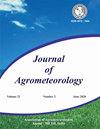Assessing the influence of elevation on satellite derived normalized difference vegetation index and land surface temperature in Rajasthan
Q3 Agricultural and Biological Sciences
引用次数: 0
Abstract
Land surface temperature (LST) and its interaction with normalized difference vegetation index (NDVI) is crucial for better understanding of environmental changes in current scenario. However, very few or scanty research on the interrelationship between LST, NDVI and topographic elements has been done in India. Therefore, the purpose of conducting this study was to examine, how LST and NDVI change as a function of elevation in Rajasthan. In present study, MODIS derived NDVI and LST and digital elevation model (DEM) from shuttle radar topography mission (SRTM) have been used. Results revealed that the LST and NDVI both were significantly influenced by elevation. Elevation, NDVI and LST varied from -6 to 1698 m, -0.09 to 0.65 and 24 to 45°C throughout the study region. In contrast to LST, which has a decreasing gradient from western to eastern portions, the spatial variability of NDVI has decreasing gradients from southern and eastern to western regions. The highest mean LST value (39.76 ± 0.2.9 0C) was obtained at an elevation range of -6 to 168 m, whereas NDVI value (0.38 ± 0.06) at elevation ranges of 589 – 1698 m. The analysis of the correlations between LST, NDVI and elevation indicated that the elevation has strong positive correlation with NDVI (r2 = 0.26) and negative correlation with LST (r2 = 0.28). Findings from this kind of research can be utilized as a platform for environmental and land use planning for sustainable ecosystem management.评估拉贾斯坦邦海拔高度对卫星得出的归一化差异植被指数和地表温度的影响
地表温度(LST)及其与归一化差异植被指数(NDVI)的相互作用对于更好地了解当前的环境变化至关重要。 然而,印度对地表温度、归一化植被指数和地形要素之间相互关系的研究很少。因此,开展本研究的目的是考察拉贾斯坦邦的 LST 和 NDVI 如何随海拔变化而变化。本研究使用了 MODIS 导出的 NDVI 和 LST 以及穿梭雷达地形图任务(SRTM)的数字高程模型(DEM)。结果显示,LST 和 NDVI 均受海拔高度的显著影响。在整个研究区域内,海拔、NDVI 和 LST 的变化范围分别为 -6 至 1698 米、-0.09 至 0.65 和 24 至 45°C。与 LST 从西部向东部递减的梯度不同,NDVI 的空间变化则是从南部和东部向西部递减的梯度。LST 平均值(39.76 ± 0.2.9 0C)在海拔-6 至 168 米范围内最高,而 NDVI 值(0.38 ± 0.06)在海拔 589 至 1698 米范围内最高。LST、NDVI 和海拔之间的相关性分析表明,海拔与 NDVI 呈强正相关(r2 = 0.26),与 LST 呈负相关(r2 = 0.28)。此类研究结果可作为环境和土地利用规划的平台,以实现可持续的生态系统管理。
本文章由计算机程序翻译,如有差异,请以英文原文为准。
求助全文
约1分钟内获得全文
求助全文
来源期刊

Journal of Agrometeorology
农林科学-农艺学
CiteScore
1.40
自引率
0.00%
发文量
95
审稿时长
>12 weeks
期刊介绍:
The Journal of Agrometeorology (ISSN 0972-1665) , is a quarterly publication of Association of Agrometeorologists appearing in March, June, September and December. Since its beginning in 1999 till 2016, it was a half yearly publication appearing in June and December. In addition to regular issues, Association also brings out the special issues of the journal covering selected papers presented in seminar symposia organized by the Association.
 求助内容:
求助内容: 应助结果提醒方式:
应助结果提醒方式:


